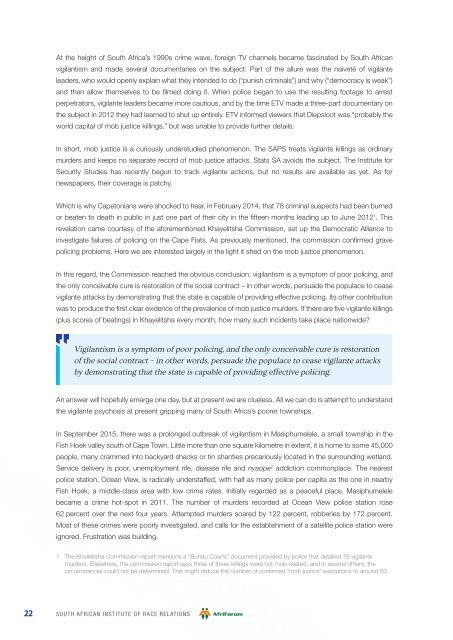2230_SAIRR_WWACinSA_sm4.indd 1 2016/09/05 5:04 PM
sairr_english_wwacinsa_print_050916
sairr_english_wwacinsa_print_050916
Create successful ePaper yourself
Turn your PDF publications into a flip-book with our unique Google optimized e-Paper software.
At the height of South Africa’s 1990s crime wave, foreign TV channels became fascinated by South African<br />
vigilantism and made several documentaries on the subject. Part of the allure was the naiveté of vigilante<br />
leaders, who would openly explain what they intended to do (“punish criminals”) and why (“democracy is weak”)<br />
and then allow themselves to be fi lmed doing it. When police began to use the resulting footage to arrest<br />
perpetrators, vigilante leaders became more cautious, and by the time ETV made a three-part documentary on<br />
the subject in 2012 they had learned to shut up entirely. ETV informed viewers that Diepsloot was “probably the<br />
world capital of mob justice killings,” but was unable to provide further details.<br />
In short, mob justice is a curiously understudied phenomenon. The SAPS treats vigilante killings as ordinary<br />
murders and keeps no separate record of mob justice attacks. Stats SA avoids the subject. The Institute for<br />
Security Studies has recently begun to track vigilante actions, but no results are available as yet. As for<br />
newspapers, their coverage is patchy.<br />
Which is why Capetonians were shocked to hear, in February 2014, that 78 criminal suspects had been burned<br />
or beaten to death in public in just one part of their city in the fi fteen months leading up to June 2012 1 . This<br />
revelation came courtesy of the aforementioned Khayelitsha Commission, set up the Democratic Alliance to<br />
investigate failures of policing on the Cape Flats. As previously mentioned, the commission confi rmed grave<br />
policing problems. Here we are interested largely in the light it shed on the mob justice phenomenon.<br />
In this regard, the Commission reached the obvious conclusion: vigilantism is a symptom of poor policing, and<br />
the only conceivable cure is restoration of the social contract – in other words, persuade the populace to cease<br />
vigilante attacks by demonstrating that the state is capable of providing effective policing. Its other contribution<br />
was to produce the fi rst clear evidence of the prevalence of mob justice murders. If there are fi ve vigilante killings<br />
(plus scores of beatings) in Khayelitsha every month, how many such incidents take place nationwide?<br />
Vigilantism is a symptom of poor policing, and the only conceivable cure is restoration<br />
of the social contract – in other words, persuade the populace to cease vigilante attacks<br />
by demonstrating that the state is capable of providing effective policing.<br />
An answer will hopefully emerge one day, but at present we are clueless. All we can do is attempt to understand<br />
the vigilante psychosis at present gripping many of South Africa’s poorer townships.<br />
In September 2015, there was a prolonged outbreak of vigilantism in Masiphumelele, a small township in the<br />
Fish Hoek valley south of Cape Town. Little more than one square kilometre in extent, it is home to some 45,000<br />
people, many crammed into backyard shacks or tin shanties precariously located in the surrounding wetland.<br />
Service delivery is poor, unemployment rife, disease rife and nyaope 2 addiction commonplace. The nearest<br />
police station, Ocean View, is radically understaffed, with half as many police per capita as the one in nearby<br />
Fish Hoek, a middle-class area with low crime rates. Initially regarded as a peaceful place, Masiphumelele<br />
became a crime hot-spot in 2011. The number of murders recorded at Ocean View police station rose<br />
62 percent over the next four years. Attempted murders soared by 122 percent, robberies by 172 percent.<br />
Most of these crimes were poorly investigated, and calls for the establishment of a satellite police station were<br />
ignored. Frustration was building.<br />
1 The Khalelitsha Commission report mentions a “Bundu Courts” document provided by police that detailed 78 vigilante<br />
murders. Elsewhere, the commission report says three of these killings were not mob-related, and in several others, the<br />
circumstances could not be determined. This might reduce the number of confi rmed “mob justice” executions to around 60.<br />
22<br />
SOUTH AFRICAN INSTITUTE OF RACE RELATIONS<br />
<strong>2230</strong>_<strong>SAIRR</strong>_<strong>WWACinSA</strong>_<strong>sm4.indd</strong> 22<br />
<strong>2016</strong>/<strong>09</strong>/<strong>05</strong> 5:<strong>04</strong> <strong>PM</strong>


